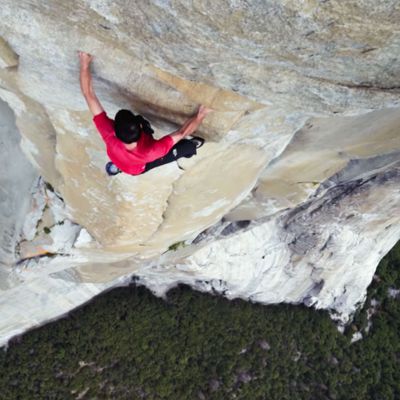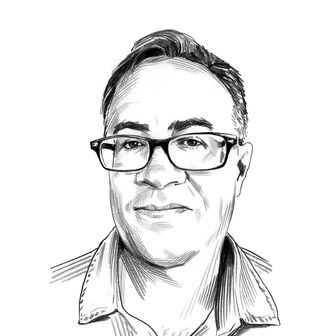
“I mean, who wakes up the morning before the NBA Championship and says, ‘I’m gonna make 100 shots today.’?”
“Or like, ‘I will not miss a free throw. Like, dude, if I miss a free throw, they will drag me off and execute me.’ ”
“But it’s a three-hour-and-56-minute basketball game where you cannot make a single mistake. And it’s not like you get dragged out, you get shot on the court.”
Jimmy Chin and Alex Honnold are extraordinary athletes, but basketball is not their sport. And they’re not renowned for their pristine analogies, either. They’re two of the most celebrated climbers in the world, struggling to find the right words to describe an astonishing act of human derring-do: On June 3, 2017, Honnold ascended the Freerider route of El Capitan, a nearly 3,000-foot rock face in Yosemite National Park, noted for its glassy-smooth granite and holds that extend only to the fingertips. And he did it all without a rope.
One hiccup in the choreography, one slip in the tiny indentations that pass for grips and footholds, one hard screech or bite from the birds and mice that populate the crevices — that’s all it would take for Honnold, a legend in the exceptionally rarefied field of “free solo” climbers, to fall to the earth. For Chin, who spent the morning of the 3rd hanging off the upper-third of El Capitan with his camera, there was always the possibility that production on Free Solo, the arresting new documentary he co-directed with his wife, Elizabeth Chai Vasarhelyi, would end with Honnold dropping out of frame. Now the three of them are reminiscing cheerily in a small hotel conference room near the Toronto Film Festival, where the film won the People’s Choice award for Best Documentary.
Honnold was a near-mythic figure in the sport before free-soloing El Cap, but his personality is curiously modest and self-effacing, to the point where he tries to downplay his achievement.
“One of the beauties of [El Cap] is that there really aren’t that many objective hazards,” he says. “There isn’t that much going on at Yosemite.”
“A piece of it fell off a few months later,” counters Vasarhelyi.
“Yeah, but that’s geology,” says Honnold. “Seriously, that’s like getting hit by a car walking across the street. It’s freak stuff.”
Calculating risk — and then reducing it as much as possible — is an important task for climbers of any kind, and it’s here that Honnold defers to Chin, who was nearly killed by an avalanche in 2003 while attempting (with Stephen Koch) to climb Mount Everest “Alpine style,” without supplemental oxygen, fixed ropes, or base camps. He returned to Everest one year later, and joined Kit and Rob DesLauriers in skiing down the summit a couple of years after that. But Chin is most popularly known for his part in a three-man climb up the “shark fin” route to the peak of Mount Meru in India, scaling rock so brittle that one swing of a pickax can break off a chunk. With a small digital camera in hand, Chin’s breathtaking you-are-there footage was worked into the 2015 documentary Meru, which he also co-directed with Vasarhelyi.
“In the mountains like Meru,” says Honnold, “avalanches and [turns in the] weather are a constant risk. You’re constantly having to evaluate and work through it. With Yosemite, you kinda don’t have to worry about that so much. You just look at the frickin’ iPhone forecast and say, ‘It’s sunny for the next ten days. I’ll just climb whenever.’”
Honnold has a relaxed confidence, but most of Free Solo chronicles the stresses of getting to the “I’ll just climb whenever” phase. It takes uniquely contradictory type of person to attempt something so absurdly dangerous, a combination of devil-may-care moxie and the meticulous planning and self-discipline to do it right. And that’s on top of the enormous physical strength and stamina necessary to pull yourself up a flat sheet of rock. (When you shake Honnold’s hand, what stands out is not its strength but its suppleness, capped by pillowy fingertips swollen wide from doing pull-ups on a fingerboard. In that sense, it feels more like gorilla than man.) Ultimately, though, the challenges were tactical and mental: Honnold is shown documenting every arm stretch and leg swing up Freerider, scripting out a precise choreography in his notebook and practicing until the moves become second nature.
Then there’s the mental part.
“I’ve been dreaming about [free-soloing El Cap] for eight years,” says Honnold. “And you see the year and a half — almost two years — of preparation throughout the course of the film. I’m physically training and preparing, memorizing and visualizing moves, and just working through that whole process. Even things like a failed attempt were part of that mental preparation, because even though I failed, I still actually hiked up to El Cap with no rope and started climbing. That was a significant step, because I could build on it the next time.”
The other major factor in Honnold’s climb is emotional. Because Free Solo is also a love story, documenting his relationship with Sanni McCandless, a similarly adventurous woman who broke through his own brittle façade like a pickax through sheet rock. Until meeting McCandless and eventually getting a place together in Las Vegas — a city they find attractive more for the hiking opportunities than the gambling — Honnold lived out of a van, parking near his conquest of the moment and subsisting on dubious-looking stir fries from a camp stove. In the film, Honnold understates just how negatively his passions affect his dating life, but in McCandless, he finds someone who’s willing to meet him halfway, even if that means accepting constant mortal peril. This was the hard part of the film for him.
“I have less personal practice with somebody being in my van holding the camera [than filming me climb],” says Honnold. “I’m not even good at talking to [McCandless] alone, and sometimes there would be three people watching you have a deep talk with your girlfriend.”
On this front, Chin and Vasarhelyi bring an insight and understanding that’s just as unique as Chin’s experiences as a climber. Vasarhelyi knows what it’s like to be at the bottom of the mountain, worrying about her husband making it down safely. She and Chin have committed to a life of art and adventure together that’s hugely fulfilling, but fraught with obvious peril. They have to accept a high degree of risk that would seem to limit intimacy: How attached can you be to someone who could die through a plausible shift in fortune? The intense dynamics of Honnold and McCandless’s relationship would be difficult for an outsider to grasp.
“I think it made me very personally invested in Alex’s relationship,” says Vasarhelyi of her connection to the pair. “I could empathize with her. Sanni is very special. She was able to advocate for herself and use this emotional vantage to help Alex get through his fears of intimacy.”
Now that he’s conquered El Capitan and accepted some degree of domestication — though he and McCandless had, however, spent the summer outdoors, living out of his van — there’s the terrifying question of what comes next for Honnold. What does a guy who climbed 3,000 feet without a rope do for an encore? On that question, Honnold is blessedly circumspect.
“I think, realistically, it wouldn’t be surprising if free-soloing El Cap is the most significant climb I’ll ever do in my life,” he says. “Since that happened, I’ve been on an expedition to Antarctica and I’ve set the speed record on El Cap, which is a different project I did with [climber] Tommy Caldwell this last summer. I’m continuing to do cool climbing projects, but I’m okay if none of them are match free-soloing El Cap.”
“You don’t always have to outdo yourself,” he continues. “At some point, you just keep on keeping on.”


